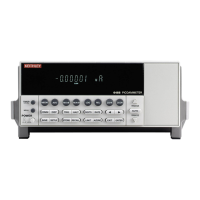9-12 Remote Operation Model 6485 Picoammeter Instruction Manual
Query commands
The query command requests the presently programmed status. It is identified by the ques-
tion mark (?) at the end of the fundamental form of the command. Most commands have a
query form.
:ARM:TIMer? Queries the timer interval
Most commands that require a numeric parameter (<n>) can also use the DEFault, MINi-
mum, and MAXimum parameters for the query form. These query forms are used to deter-
mine the *RST default value and the upper and lower limits for the fundamental
command.
:ARM:TIMer? DEFault Queries the *RST default value
:ARM:TIMer? MINimum Queries the lowest allowable value
:ARM:TIMer? MAXimum Queries the largest allowable value
Case sensitivity
Common commands and SCPI commands are not case sensitive. You can use upper or
lower case and any case combination. Examples:
*RST = *rst
:DATA? = :data?
:SYSTem:PRESet = :system:preset
Long-form and short-form versions
A SCPI command word can be sent in its long-form or short-form version. The command
tables in this manual use the long-form version. However, the short-form version is indi-
cated by upper case characters.
:SYSTem:PRESet long-form
:SYST:PRES short form
:SYSTem:PRES long-form and short-form combination
Note that each command word must be in either long-form or short-form. For example,
:SYSTe:PRESe is illegal and will generate an error. The command will not be executed.
Short-form rules
Use the following rules to determine the short-form version of any SCPI command:
• If the length of the command word is four letters or less, no short form version
exists.
:auto = :auto

